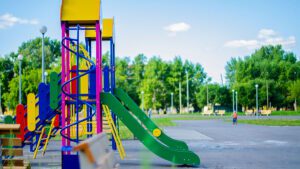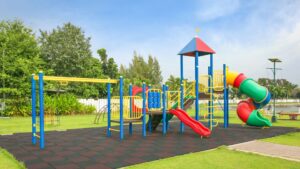A abertura de um parque de trampolins pode ser um passo emocionante - e potencialmente lucrativo - para o negócio. Mas é também um negócio de capital intensivo. Se pretende realmente abrir um parque, precisa de um orçamento claro que cubra a instalação inicial, a segurança e a conformidade, as operações em curso e uma almofada para o inesperado.
Resumo rápido (se estiveres com pressa)
- Gama típica de arranque (equipamento + equipamento): $233,000–$467,000 (estimativa do parque médio)
- Seguro (anual): $5,800–$11,700 (estimativa)
- Principais factores de custo: edifício (comprar ou alugar), seleção de equipamento, renovação do local, pessoal, marketing, sistemas de segurança e manutenção.
- Sugestão: Planear por fases - abrir com as atracções principais, depois acrescentar caraterísticas quando o fluxo de caixa estabilizar.

1. Explicação dos principais custos iniciais
1.1 Construção: comprar, alugar ou construir de raiz?
- Comprar proporciona estabilidade a longo prazo, mas exige um maior investimento inicial e, potencialmente, grandes renovações. As necessidades de capital são mais elevadas, mas o controlo é maior.
- Aluguer reduz o capital inicial e permite-lhe abrir mais rapidamente, mas as condições de arrendamento podem limitar a capacidade de efetuar alterações estruturais (e a renda pode aumentar).
- Nova construção é ideal para uma apresentação personalizada, mas demora mais tempo (frequentemente um ano ou mais) e custa mais.
A sua escolha determina muitos custos a jusante: AVAC, requisitos de altura do teto, suportes estruturais para atracções altas e estacionamento.
1.2 Equipamento e atracções (artigos de grande valor)
Os parques de trampolins modernos são centros de actividades múltiplas. As atracções típicas incluem:
- Bancos de trampolins de salto livre
- Pistas de tumbling
- Fossas de espuma e airbags
- Campos de Dodgeball
- Basquetebol de trampolim
- Percursos de obstáculos ao estilo ninja
- Funcionalidades interactivas e de RA
Orçamento médio do equipamento para um parque de dimensão média foi estimado em $200k-$400k. Esse intervalo depende do número e da variedade de atracções, da personalização e do equipamento novo ou usado.
1.3 Disposição, segurança e estrutura
Não economize:
- Pavimentos e estofos de impacto
- Saídas de incêndio, sprinklers, detectores de fumo
- Suportes estruturais e ancoragens robustos
- Iluminação, som e ventilação
- Acesso ADA e casas de banho
Estes custos de construção variam muito consoante o estado do edifício escolhido, mas podem muitas vezes rivalizar com os custos de equipamento em propriedades mais antigas.

2. Custos de funcionamento que devem ser orçamentados
2.1 Pessoal
Um parque de trampolins requer muito pessoal. As funções incluem:
- Receção
- Assistentes/supervisores de trampolins (pessoal de segurança)
- Pessoal de restauração e bebidas (se aplicável)
- Coordenadores de eventos (festas, reservas de empresas)
- Limpadores e técnicos de manutenção
- Diretor e assistentes de direção
Regra geral: ter pelo menos um supervisor formado para cada ~30 jogadores. Se o seu parque funcionar durante muitas horas (mais de 70 horas/semana), conte com duas equipas completas.
2.2 Manutenção e peças
O equipamento necessita de atenção constante: substituição de estofos, molas, tapetes e hardware. A manutenção preventiva reduz o tempo de inatividade, mas custa dinheiro. Planeie um orçamento de manutenção anual e acompanhe os ciclos de substituição dos artigos de desgaste elevado.
2.3 Marketing e aquisição de clientes
Atribuir um orçamento de marketing significativo para:
- Anúncios digitais locais (Google/FB/Instagram)
- Eventos e parcerias escolares
- Relações públicas e contacto com a comunidade
- Promoções sazonais
Um plano de marketing sólido para a fase de abertura é essencial para acelerar o boca-a-boca e gerar reservas antecipadas para festas e grupos.
2.4 Seguros e gestão de riscos
O seguro não é negociável. A estimativa inicial de $5,000-$10,000 por ano, anualmente. Este seguro cobre os riscos do edifício/propriedade e o seguro de responsabilidade civil. Os prémios reais dependem da localização, do historial de sinistros, das medidas de segurança e dos limites de cobertura.
Investir na formação do pessoal e em sistemas de segurança documentados - as seguradoras recompensam os operadores de menor risco com melhores taxas.

3. Estratégias de financiamento
3.1 Vias de financiamento comuns
- Empréstimos bancários/empréstimos comerciais: opção tradicional; comparar taxas de juro e condições de reembolso.
- Investidores em acções: um investidor pode injetar capital em troca de propriedade, mas espera mudanças na governação e expectativas de saída.
- Subvenções: raras para o entretenimento, mas podem aplicar-se algumas subvenções para o desenvolvimento económico local ou fundos para pequenas empresas.
- Financiamento do fornecedor/locação financeira: por vezes, os fabricantes de equipamento oferecem opções de financiamento.
3.2 Sugestões orçamentais
- Implementação faseada: abrir com as atracções principais e adicionar mais tarde caraterísticas especializadas.
- Projecções de receitas conservadoras: não sobrestime o número de participantes - elabore o seu plano de tesouraria com base em números realistas.
- Fundo de reserva: manter uma margem de manobra (10-20% do capex inicial) para custos adicionais inesperados.

4. Considerações sobre o layout e a experiência do hóspede
4.1 Fluxo e visibilidade
Conceba linhas de visão claras para que os supervisores e os pais possam monitorizar facilmente a atividade. Separe as zonas de alta energia (dodgeball, pistas ninja) das zonas para crianças e famílias.
4.2 Espaços para festas e eventos
As festas de aniversário e os eventos de grupo são impulsionadores de receitas - conceba salas de festas dedicadas para uma rotação eficiente e vendas adicionais.
4.3 Alimentação e bebidas
Acrescente um simples café ou snack-bar para obter receitas durante o tempo de permanência. Pense em arrendar a um parceiro se o serviço alimentar não for a sua competência principal.
4.4 Acessibilidade e inclusividade
Assegurar a conformidade com a ADA e considerar a possibilidade de realizar sessões sensíveis aos visitantes neurodiversos.

5. Segurança e conformidade: não negociáveis
- Cumprir os códigos de construção locais e todas as normas de segurança do sector.
- Aplicar regras de segurança escritas, sinalização e sessões de orientação orientadas pelo pessoal.
- Manter listas de controlo diárias e registos de manutenção.
- Disponibilizar kits de primeiros socorros, AEDs e pessoal treinado no local.
Sistemas de segurança sólidos reduzem a responsabilidade e aumentam a confiança dos clientes - ambos cruciais para o sucesso a longo prazo.

6. Fluxos de receitas e alavancas de lucro
- Entrada geral e taxas de salto por hora
- Festas de aniversário e reservas de grupos
- Assinaturas e passes de temporada
- Mercadorias e concessões
- Eventos empresariais e pacotes de formação de equipas
- Eventos especiais fora de horas (aulas de fitness, ligas de trampolins)
Maximizar os gastos por visitante com complementos (meias, cacifos, pacotes de fotografias).

7. Conselhos práticos dos operadores
- Fazer um estudo de mercado aprofundado: demografia, concorrência, calendários escolares e sensibilidade local aos preços.
- Escolha bem o local: a acessibilidade e o estacionamento são tão importantes como o aluguer.
- Dar prioridade à segurançaUm único incidente de segurança pode prejudicar a reputação.
- Contratar e formar bemO pessoal de qualidade garante a segurança e o regresso dos hóspedes.
- Começar com pouco dinheiro e expandirvalidar o seu conceito e depois escalar.
Um parque de trampolins pode ser simultaneamente um centro comunitário alegre e um negócio rentável - mas apenas com um planeamento minucioso. Planeie de forma realista o capital inicial (espere ≈ $233k-$467k para uma instalação média), ter em conta o seguro anual (≈ $5.8k-$11.7k), e dar prioridade à segurança e ao marketing desde o primeiro dia. Com um financiamento inteligente, um lançamento faseado e operações sólidas, é possível construir uma atração sustentável e divertida que faça com que os clientes voltem sempre.




